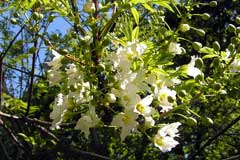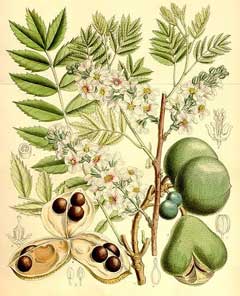 |
|
commons.wikimedia.org/wiki/User:Athenchen |
 |
| commons.wikimedia.org/wiki/File:Xanthoceras_sorbifolia.jpg |
Translate this page:
Summary
Bloom Color: White. Main Bloom Time: Early spring, Late spring, Mid spring. Form: Rounded.
Physical Characteristics

 Xanthoceras is a deciduous Shrub growing to 6 m (19ft) by 2.5 m (8ft) at a slow rate.
Xanthoceras is a deciduous Shrub growing to 6 m (19ft) by 2.5 m (8ft) at a slow rate.
See above for USDA hardiness. It is hardy to UK zone 6 and is not frost tender. It is in flower from May to June, and the seeds ripen from September to October. The species is hermaphrodite (has both male and female organs).
Suitable for: light (sandy), medium (loamy) and heavy (clay) soils and prefers well-drained soil. Suitable pH: mildly acid, neutral and basic (mildly alkaline) soils. It cannot grow in the shade. It prefers dry or moist soil.
UK Hardiness Map
US Hardiness Map
Synonyms
Plant Habitats
Edible Uses
Flowers - cooked[2, 105, 183]. They are usually boiled[179]. Leaves - cooked[2, 105, 183]. They are usually boiled[179]. Seed - cooked[2, 105, 177]. The seed is about the size of a pea, it is quite sweet[183], with a taste like a sweet chestnut[178]. The seed is husked and then ground into a powder and boiled[179].
References More on Edible Uses
Medicinal Uses
Plants For A Future can not take any responsibility for any adverse effects from the use of plants. Always seek advice from a professional before using a plant medicinally.
None known
References More on Medicinal Uses
The Bookshop: Edible Plant Books
Our Latest books on Perennial Plants For Food Forests and Permaculture Gardens in paperback or digital formats.

Edible Tropical Plants
Food Forest Plants for Hotter Conditions: 250+ Plants For Tropical Food Forests & Permaculture Gardens.
More

Edible Temperate Plants
Plants for Your Food Forest: 500 Plants for Temperate Food Forests & Permaculture Gardens.
More

More Books
PFAF have eight books available in paperback and digital formats. Browse the shop for more information.
Shop Now
Other Uses
References More on Other Uses
Cultivation details
Prefers a good loamy soil[1], but succeeds in most well-drained fertile soils in a sunny position[184, 200]. Prefers a warm dry situation[184]. Requires protection from cold winds[202]. Dormant plants are hardy to about -20°c[184]. They grow best in areas with warm summers and dry springs without late frosts[184], the young growth can be damaged by late spring frosts[1, 11]. They require summer heat in order to fully ripen their wood and to stimulate the production of flower buds[11, 200]. They are subject to attacks by 'coral spot' fungus, particularly if the wood is not fully ripened and is then damaged by winter cold[11]. Flowers are produced on the previous year's wood[202]. Plants are usually slow to become established[202]. Special Features:Not North American native, Fragrant flowers, Blooms are very showy. For polyculture design as well as the above-ground architecture (form - tree, shrub etc. and size shown above) information on the habit and root pattern is also useful and given here if available. The plant growth habit is a standard with a non-suckering single trunk [1-2].
References Carbon Farming Information and Carbon Sequestration Information
Temperature Converter
Type a value in the Celsius field to convert the value to Fahrenheit:
Fahrenheit:
The PFAF Bookshop
Plants For A Future have a number of books available in paperback and digital form. Book titles include Edible Plants, Edible Perennials, Edible Trees,Edible Shrubs, Woodland Gardening, and Temperate Food Forest Plants. Our new book is Food Forest Plants For Hotter Conditions (Tropical and Sub-Tropical).
Shop Now
Plant Propagation
Seed - 3 months cool stratification improves germination rates[113] so the seed is probably best sown in a cold frame in the autumn[K]. Another report says that the seed can be sown in a warm greenhouse in February or March[78], probably after stratification[K]. When large enough to handle, prick the seedlings out into individual pots. Grow the on in a lightly shaded position in a greenhouse for their first winter then plant them out into their permanent positions in late spring or early summer. Consider giving them some protection from winter cold for their first winter or two outdoors. Root cuttings, 3cm long planted horizontally in pots in a frame in December or January. Good percentage[78]. Division of suckers in the dormant season[200]. They can be planted out straight into their permanent positions.
Other Names
If available other names are mentioned here
Native Range
TEMPERATE ASIA: Gansu Sheng, Hebei Sheng, Henan Sheng, Korea, Liaoning Sheng, Nei Mongol Zizhiqu, Ningxia Huizi Zizhiqu, Shaanxi Sheng, Shandong Sheng, Shanxi Sheng,China.
Weed Potential
Right plant wrong place. We are currently updating this section.
Please note that a plant may be invasive in one area but may not in your area so it's worth checking.
Conservation Status
IUCN Red List of Threatened Plants Status :

Growth: S = slow M = medium F = fast. Soil: L = light (sandy) M = medium H = heavy (clay). pH: A = acid N = neutral B = basic (alkaline). Shade: F = full shade S = semi-shade N = no shade. Moisture: D = dry M = Moist We = wet Wa = water.
Now available:
Food Forest Plants for Mediterranean Conditions
350+ Perennial Plants For Mediterranean and Drier Food Forests and Permaculture Gardens.
[Paperback and eBook]
This is the third in Plants For A Future's series of plant guides for food forests tailored to
specific climate zones. Following volumes on temperate and tropical ecosystems, this book focuses
on species suited to Mediterranean conditions—regions with hot, dry summers and cool, wet winters,
often facing the added challenge of climate change.
Read More
Expert comment
Author
Bunge.
Botanical References
11200266
Links / References
For a list of references used on this page please go here
Readers comment
| Add a comment |
|
If you have important information about this plant that may help other users please add a comment or link below. Only comments or links that are felt to be directly relevant to a plant will be included. If you think a comment/link or information contained on this page is inaccurate or misleading we would welcome your feedback at [email protected]. If you have questions about a plant please use the Forum on this website as we do not have the resources to answer questions ourselves.
* Please note: the comments by website users are not necessarily those held by PFAF and may give misleading or inaccurate information.
To leave a comment please Register or login here All comments need to be approved so will not appear immediately.
|
|